Colt and his rifles: when persistence is not the time
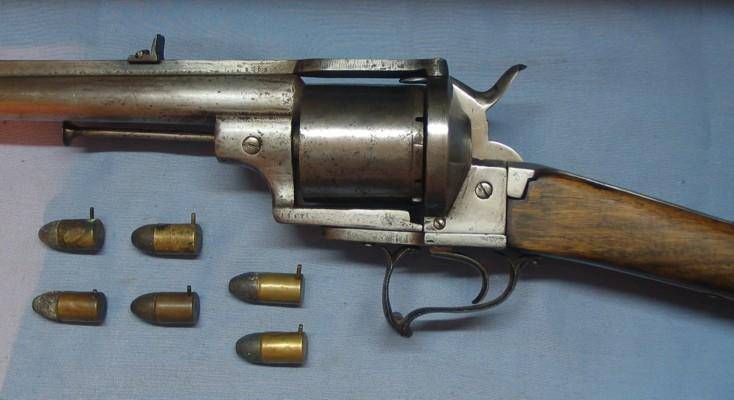
Janson August's 15-mm Lefoshe system caliber revolver gun and ammunition for it. Revolving rifles were generally very popular weapons at the beginning of the XNUMXth century Photography by Alain Dobress
I do not have much time. –
Dakota didn't take his eyes off the fox-faced man.
And he seemed completely weak-willed and upset.
- Well, well, so, so!
But I suffer a loss, a big loss!
As soon as I get over this.
This is truly a gift to the great leader!
Liselotte Welsskopf-Heinrich "Tokei Ito"
Weapon stories. Samuel Colt was, without a doubt, an extraordinary man: active, assertive, an excellent advertiser, but at the same time he was still an ordinary person who also had many shortcomings. Well, not everyone has the gift of foresight. Someone is too arrogant or has his own threshold of incompetence, above which he is no longer destined to rise.
And it also happens that even the most talented people pass by a “gift of fate”, and then regret it for the rest of their lives. So Colt also stumbled on one such ill-conceived decision, but he did not have to regret it, since he died in 1862.
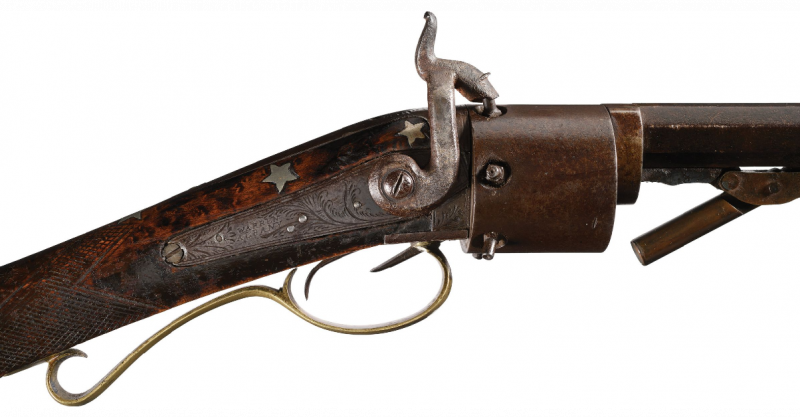
Capsule drum gun of an unknown German manufacturer. Beginning of the XNUMXth century Photo of Rock Island Auction
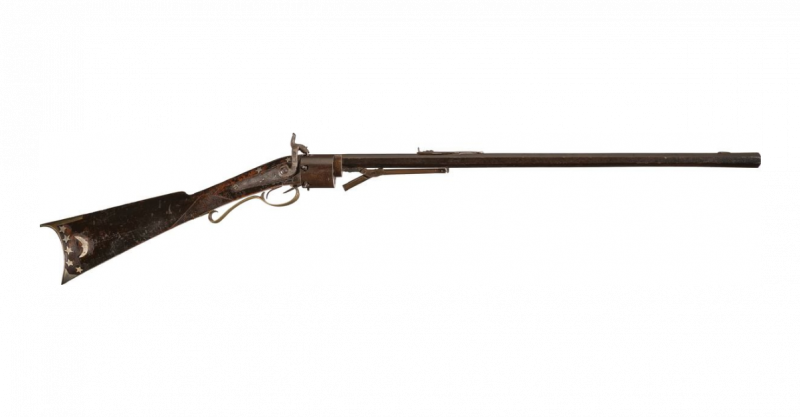
It's the same gun
For some reason, Colt did not appreciate the proposal of his employee Rollin White, who not only invented a mechanism for quickly loading a revolver, but also patented a revolver drum drilled through, which deprived Colt of any opportunity to produce cartridge revolvers. White's patent was issued on April 3, 1855, for a period of seven years, then extended and valid until April 3, 1869.
But the management of the Smith and Wesson company turned out to be more far-sighted, bought the rights to the White drum and already at the end of 1857 produced the world's first revolver chambered for a metal rimfire cartridge.
So Colt lost the chance to take over the entire US arms industry and become the only manufacturer of revolvers in the country in general!
And so, after his death, his widow had to try a lot to ensure that the company she inherited “kept the bar” and, although she succeeded, she had to put a lot of work into it, although initially everything just rested on acquiring Rollin White’s patent!
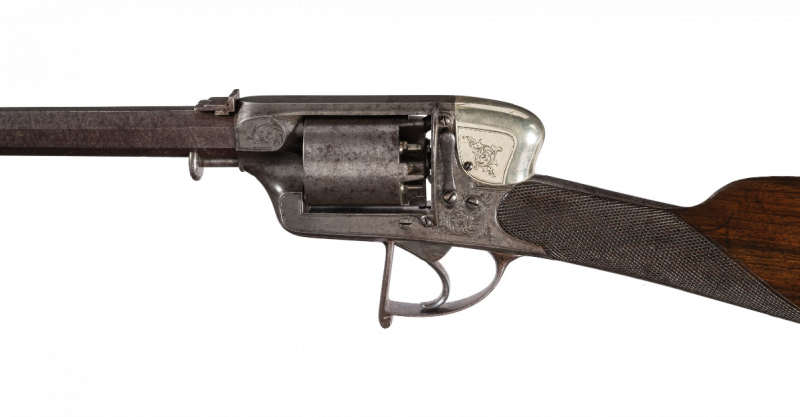
Dean Adams & Dean Percussion Drum Shotgun. Beginning of the XNUMXth century Photo of Rock Island Auction
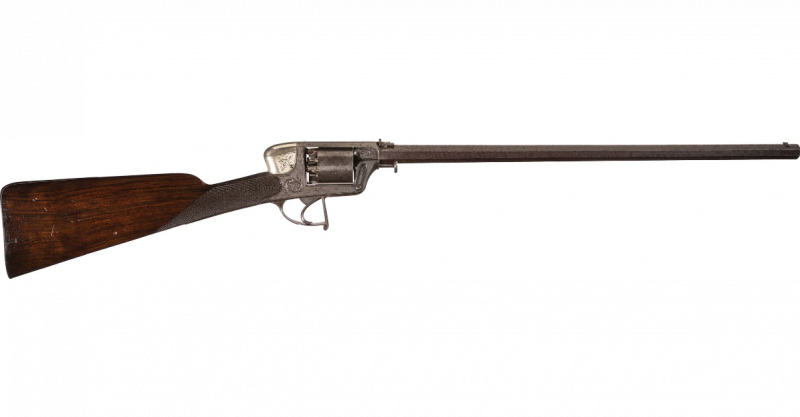
It's the same gun
But Colt showed considerable tenacity and perseverance in the development and production of... drum rifles! Well, for some reason he really wanted to promote this particular type of weapon.
It would seem that you make excellent revolvers, the market shows a steady demand for them. What else do you need?
But no, Colt strived with all his might to create capsule revolving rifles and carbines and offered them to the American military with enviable regularity, and with the same regularity they were either abandoned completely or purchased in such tiny quantities that Colt’s appetites could not satisfy at all!
However, the reasons why he began production of his revolving rifles were quite prosaic. The fact is that in 1835 the United States began the Second Seminole War against the Seminole Indians in Florida. We had to fight in the specific conditions of the swampy jungle.
The Seminoles ambushed American soldiers, and at close range. They fired a volley at them, but while they were reloading their guns, the Seminoles ran to their position and... killed them with cold steel! The army needed something quick-firing, and that’s when the first Colt capsule guns were born!
The Seminoles were never defeated, and in principle they are still at war with the United States today, which led to the third Seminole War, which began in 1855. The situation with ambushes and unexpected attacks repeated itself. But here the means to resist them was known - the “drum gun.”
The Colt company already in the same 1855 began producing such guns and supplying them to the army. Their design was essentially similar to his revolvers with a rotating cylinder that held five or six cartridges depending on the caliber from 0,36 to 0,64 inches. The design used was that of the Colt M1855 Side Trigger pocket revolver, designed by Elisha K. Root.
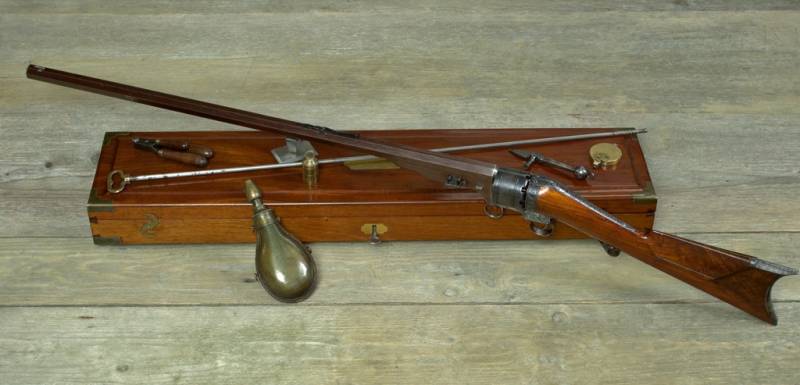
1838 Colt-Paterson Ring Lever Rifle. Colt's first such rifle to be mass-produced.
Colt's revolving rifles were the first repeating rifles adopted by the US government, but they had their problems.
Officially they were given to soldiers because of their rate of fire. But after six shots, the shooter had to spend too much time reloading. In addition, sometimes Colt rifles experienced drum ruptures. Despite this, an early model was used in the Seminole War in 1838.
In March 1836, Colt founded the Patent Arms Company and began operating an unused silk mill on the banks of the Passaic River in Paterson, New Jersey. His first product was a ring-lever revolver rifle, available in .34, .36, .38, .40 and .44 calibers, in which a ring located in front of the trigger served to cock the hammer and rotate the cylinder for each shot.
Colt's revolver rifles proved highly effective against the Seminoles, and the Army purchased them for use by troops in the Florida Campaign. In 1855, after receiving a patent for the Model 1855, Colt introduced the "Side Trigger" revolver, also known as the "Root" in honor of Elisha K. Root, who at the time served as plant manager, chief engineer, and creator.
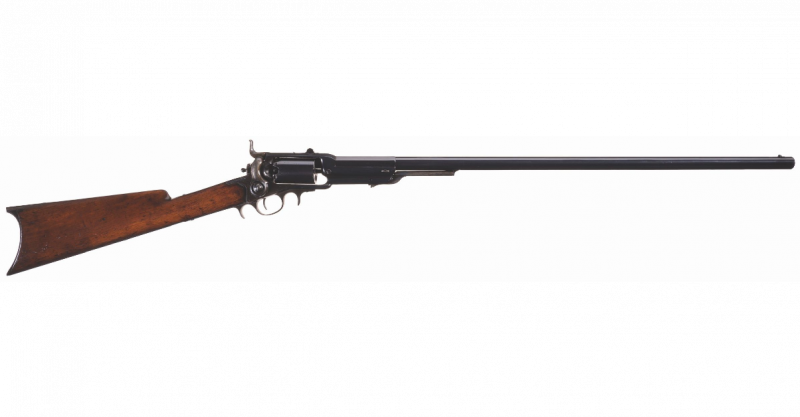
Colt M1855 sporting rifle. Photo of Rock Island Auction
Based on its design, the Colt company released the M1855 rifles and carbines for military and sporting purposes. Both a long-barreled rifle and a shortened carbine were produced. In 1855, it became the first repeating rifle adopted for service in the United States, but the problems associated with the specifics of its design were ultimately not overcome.
The problem was that in field conditions, gunpowder sometimes spilled out of paper cartridges and lingered in various recesses around the magazine.
Ball-shaped and cylindrical bullets were placed in the chambers of the drum directly on the gunpowder, and it happened that between them and the walls of the chamber there were cavities and leaks, where gunpowder also got into.
When fired, hot gases flowing from the gap between the drum and the barrel ignited this gunpowder, which in turn ignited the gunpowder in the chambers awaiting the shot. This phenomenon was called "chain fire" and was relatively common with early cap-fired revolver firearms.
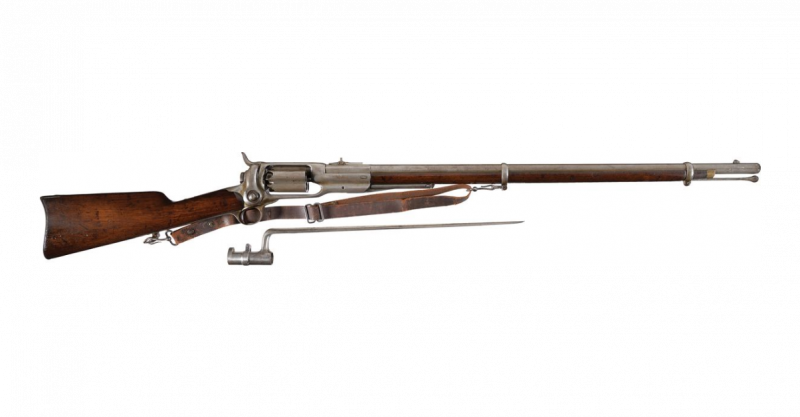
Colt M1855 rifle with bayonet. Photo of Rock Island Auction
When this happened with a Colt revolver rifle, shards of metal fell into the shooter's left hand. Commanders tried to get around the problem in different ways. The rifle had to be cleaned properly and thoroughly, as careless cleaning could leave it with residue that would increase the risk of a chain fire.
Some commanders instructed their men to fire the weapon only while supporting it directly in front of the trigger guard or holding the loading lever down, which reduced the danger to the left hand in the event of a magazine explosion. It was proposed to load only one chamber, but this deprived the rifle of all its advantages.
There was, of course, a radical way to avoid “chain fire” - to cover the hole of the charged drum with “cannon lard,” a special thick lubricant based on lard and stearin. But it turned out to be very difficult to use it in a combat situation, where every second of the road, covering 5-6 chambers with this lubricant.
This also happened with revolvers, but since they were fired from an outstretched arm, no injuries to the hands were observed in this case! And in addition to everything else, the rifle also sent fragments from the capsules being broken into the left hand into the left hand.

Colt-Root revolver rifles were manufactured in Belgium under license from the Colt Company in the 1850s and 1860s.
The Model 1855, which was the most famous revolving rifle, was available in .36, .44 and .56 (14,22 mm) calibers. Rifles were produced with barrels of the following lengths: 15, 18, 21 and 24 inches. A six-shot cylinder was used if the rifle caliber was .36 or .44. If the caliber was .56, then a five-round drum was used. Some models could be equipped with bayonets.
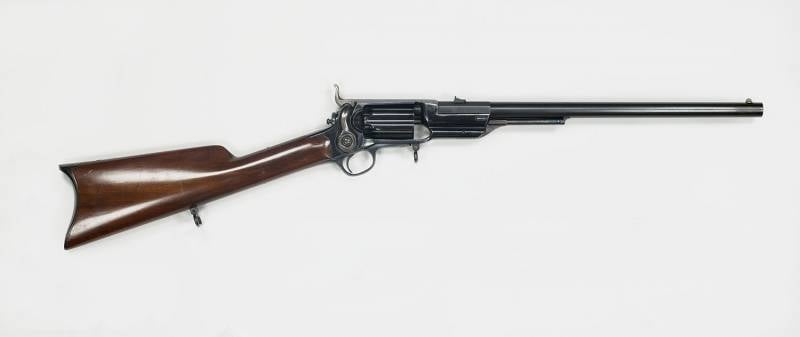
Colt Carbine 1857 Hartford. Caliber .56. Barrel length: 45 cm. Wadsworth Atheneum Museum of Art, Hartford, Connecticut, USA
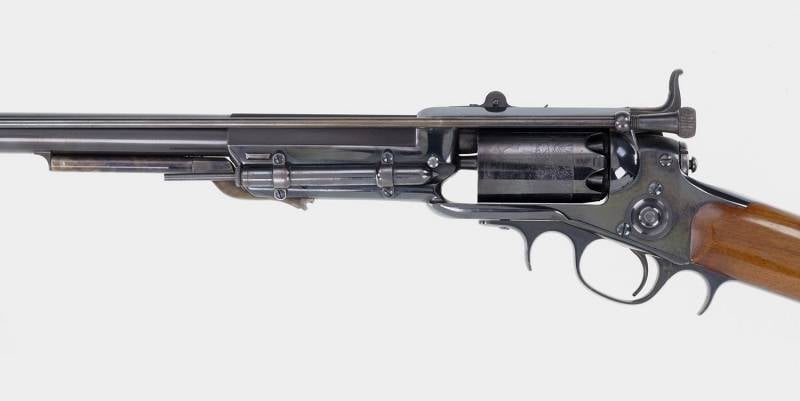
1857 Colt rifle with sniper scope. Caliber: .36 (7,62 mm). Barrel length: 68 cm. Wadsworth Atheneum Museum of Art, Hartford, Connecticut, USA
Interestingly, the eight men guarding the most dangerous route between Independence, Missouri and Santa Fe were also armed with revolver carbines and Colt pistols. When it was doubted that eight men could effectively carry mail on this section of the route, the Missouri government stated that “these eight men are ready, if attacked, to fire 136 rounds without the need for reloading. So we are not afraid for the security of the mail.” And yes, all mail deliveries along this route went quite safely.
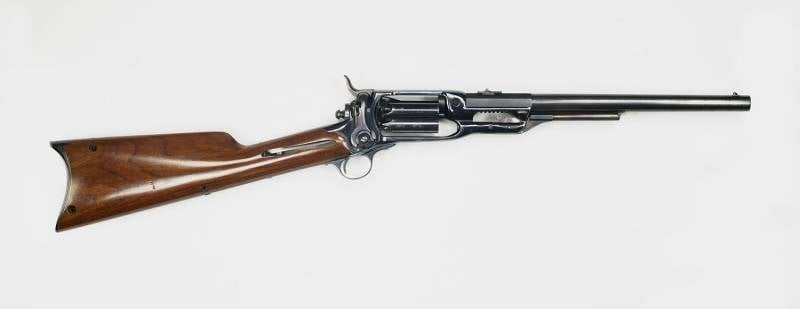
Colt 1858 Hartford Revolving Carbine. Caliber .56. Wadsworth Atheneum Museum of Art, Hartford, Connecticut, USA
Before the Civil War, the US government purchased 765 Colt revolver carbines and rifles. Many of them were sent to the southern states and eventually ended up with the Confederates. After the outbreak of war, approximately 4 to 400 were purchased.
They performed admirably in combat at the Battle of the Boyne, the Battle of Murfreesboro, and Snodgrass Hill during the American Civil War. During the battle at the Boyne, the Confederates believed that they were facing an entire division, and not just one regiment, so strong was the fire from the Northerners.
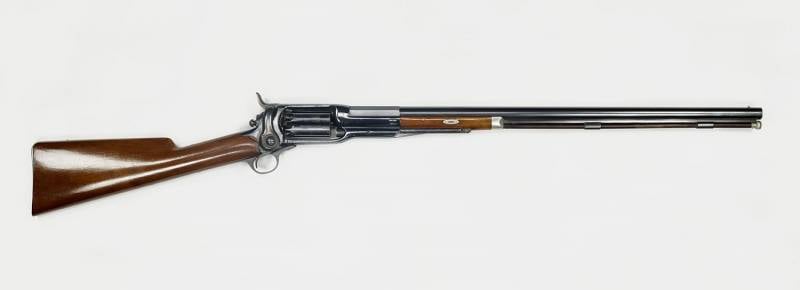
1860 Hartford Rifle. Caliber: .60 (15,2 mm). Barrel length: 68 cm. Wadsworth Atheneum Museum of Art, Hartford, Connecticut, USA
But, despite the success, the rifle’s shortcomings turned out to be fatal for it.
The Council of Officers decided to stop using revolving cap rifles in the army. And they were sold for 42 cents each, when they were bought for 44 dollars. This led to their wide distribution among private individuals, who were not too lazy to seal the chambers before firing, so that at the everyday level, drum ruptures were practically not observed.
Interestingly, a Colt revolver rifle was used by Ned Kelly during a shootout with Victoria State Police in Australia back in 1880.
Information